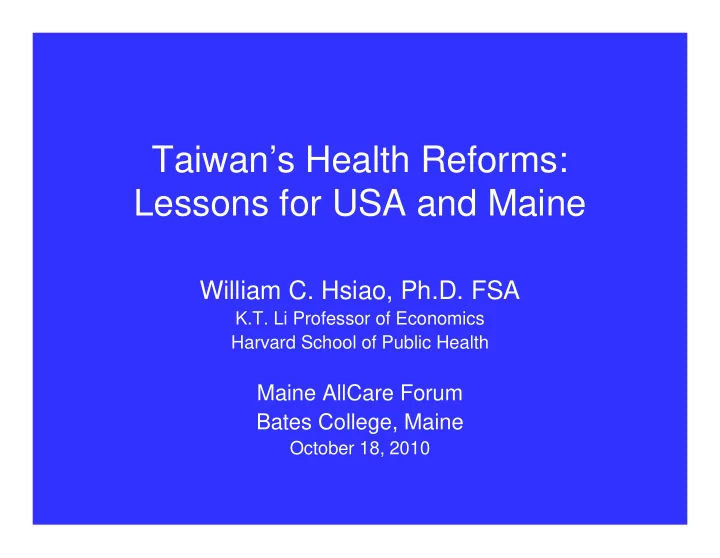

Taiwan’s Health Reforms: Lessons for USA and Maine William C. Hsiao, Ph.D. FSA K.T. Li Professor of Economics Harvard School of Public Health Maine AllCare Forum Bates College, Maine October 18, 2010
Background Information on Taiwan • Land size: about 1/3 of Maine • Population: 23 million people (about 18 times of Maine population). • Income (GDP per capita, 2009)-- $32,000 (PPP basis) Income (GDP per capita in 1995 when NHI was implemented) -- $13,000 (PPP basis)
Major Problems Confronting Taiwan in late 1980’s • Majority of Taiwanese had no health insurance, many lack adequate access to health care. • Taiwan had multiple health insurance plans, but they only covered civil servants, farmers, and workers (but not their families). • High health cost inflation • Uneven quality of health services. • Inefficiency, waste, and abuse in health care.
Taiwan’s Goals for Reform • Provide health insurance coverage for all Taiwan residents. • Improve equitable access to health care, particularly for poor and low-income people and residents in remote areas. • Improve quality and efficiency of health care. • Control health expenditure inflation so health spending is affordable and cost of health insurance is sustainable.
Taiwan’s Reforms • Universal coverage, pool risks nationwide, equity in finance: � Mandate all employers and individuals to join NHI. � Finance by premium contribution based on a payroll tax � Government subsidizes the poor, the veterans, farmers and self employed • Equal access: uniform comprehensive benefit package, include dental, Chinese medicine, and home care. • Built-up supply in under-served areas. • Providers: continue to pay on fee-for-services basis, but introduced uniform fee schedule and global budget. • Single payer—government (Bureau of NHI)
Single Payer Allowed Taiwan to Organize: • Uniform administrative procedures for patients’ access (Smart Care card) and claim payment � reduce paper work and administrative expenses • Uniform electronic patient records � improve the continuity and effectiveness of health care and reduce repetition of tests • Uniform claim records � Can produce complete profile of providers’ medical practice and billing; reduce fraud, over-charges, over-treatments and billing.
Taiwan’s NHI achievements • Expanded insurance coverage from less than 60% to 92% of the population in a year. Now it’s close to 100%. • Improved the access to health care for the poor and people living in remote areas. • Narrowed the disparity between the rich and poor in utilization rates. • Shifted the emphasis to prevention and primary care. • Improved the health outcomes for poor and low income people when they have strokes and heart attacks.
Growth Rates of Medical Expenditures in Selected Countries from 1997 to 2006 ������������������������
Public Satisfaction Ratings for NHI ������������������������������������������������
Remaining Challenges Confronting Taiwan • Establish an Integrated Delivery System care to improve quality and efficiency of health care. • Assure fairly uniform quality of health services and remove current inappropriate care (many visits and over-use of drugs). • Address the deficit of the NHI Fund due to an omission in the NHI law.
Major Problems confronting USA • Lack of universal health insurance coverage—now mostly addressed by Obama’s Affordable Care. • Uneven quality of health care • Inefficiencies—emphasis specialty treatment rather prevention and primary care, duplication of tests, over- treatment, waste, abuse, and fraud. • Significant share of physician time and health expenditure spent on myriad of administrative requirements imposed by multiple insurance plans.
Lessons for USA and Maine (I) • Taiwanese health SYSTEM was broken and archaic. Is the current US system in a similar situation? • We know how to fix a broken system and modernize it for the 21th century. Taiwan is a case among the advanced economies. • Taiwan still has an archaic health care delivery system that needs fixing.
Lessons for USA and Maine (II) • Universal health insurance coverage with comprehensive services is possible, but must have law that mandates everyone to be insured. • Single payer can control health expenditure inflation: � Taiwan now sp ends 6.1% of its GDP on health. � NHI if financed by premium assessed as 4.55% of payroll. • Public satisfaction can be high and sustained in a single payer system. • Fee-for-service payment is inflationary and wasteful, but providers strongly resist reform. Taiwan had to resort to a global budget method ( a “second best” solution). • Payment method must be reformed if Taiwan wants to move to an modern integrated delivery system. • Some co-payment are necessary to moderate demand for “unnecessary” services and drugs.
FIN
Recommend
More recommend